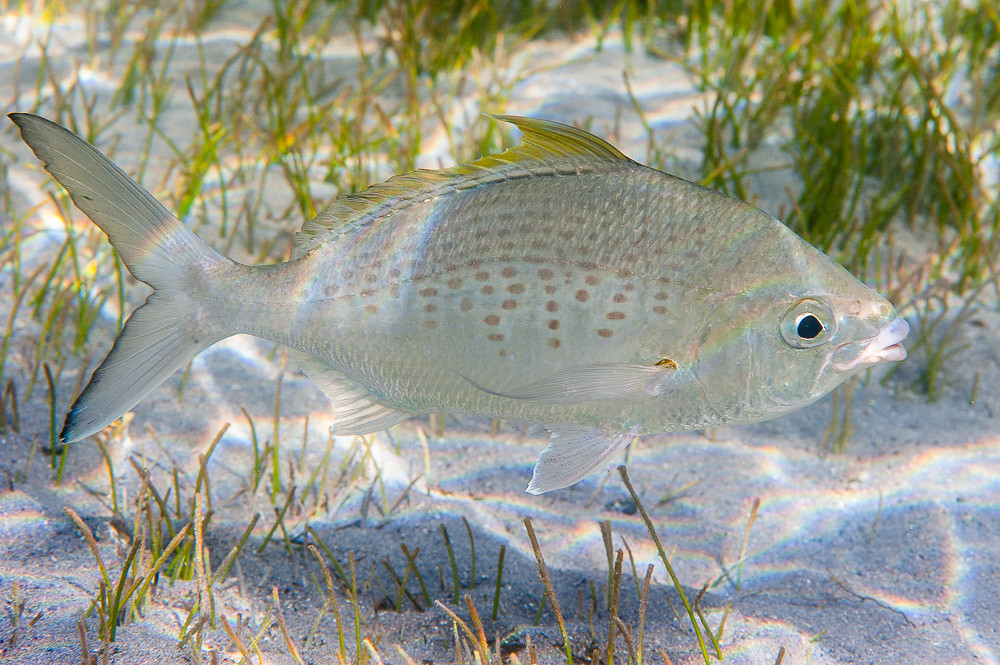- Classification
- ACTINOPTERYGII
- PERCIFORMES
- GERREIDAE
- Gerres
- longirostris
Strongspine Silverbiddy, Gerres longirostris Lacépède 1801
Other Names: Strong-spined Silver-biddy

A Strongspine Silverbiddy, Gerres longirostris, at Reunion Island in the Indian Ocean, January 2017. Source: zsispeo / Flickr. License: CC by Attribution-NonCommercial-ShareAlike
Summary:
Live specimens' head and trunk sides olive-green above, becoming silvery below; snout region blackish dorsally; dorsal fin membrane with faint black blotches or small spots at each spine and ray, just above edge of scaly basal sheath, silvery anteriorly on 1st-5th dorsal spine, grading to hyaline on spinous and soft dorsal fin; anal fin scaly basal sheath silver; distal part of pelvic fin between 1st-5th soft rays often white or hyaline for 1/5-1/3 of ray length, other parts hyaline or slightly yellowish; pectoral and anal fins hyaline. Caudal fin dusky with broad darker margin posteriorly which may be indistinct in old or poorly preserved specimens; ventral edge of lower caudal fin lobe white or bluish-white. Generally, body with prominent dark stripes along scale rows above lateral line (distinct in preserved specimens); 4-9 somewhat oblique dusky bars or columns of ovoid dark spots immediately below lateral line in specimens over 10 cm SL (dusky bars on less than 10 cm) but more apparent in preserved or stressed individuals.
Cite this page as:
Bray, D.J. 2020, Gerres longirostris in Fishes of Australia, accessed 28 Jun 2025, https://fishesofaustralia.net.au/home/species/2434
Strongspine Silverbiddy, Gerres longirostris Lacépède 1801
More Info
|
Distribution |
Gove, Northern Territory, to Mackay, Queensland; also Cocos (Keeling) Islands in the eastern Indian Ocean. Elsewhere the species is widespread in the tropical east-Indo-west-central Pacific: Red Sea and South Africa to the Marquesas Islands, north to the Ryukyu Islands, south to Australia. Inhabits shallow sandy areas on coral reefs, lagoons and estuaries. Adults prefer clear coastal waters, while juveniles are often seen in estuaries and lagoons. |
|
Features |
Dorsal fi IX, 10; Anal fin III, 7; Scales between base of 5th dorsal-fin spine and lateral line 5-6.5. Body depth max 2.3-2.8 in SL; upper jaw extending vertically beyond anteriormost margin of dermal eye opening, sometimes reaching to vertical at anterior margin of pupil; second dorsal fin spine longest, 17-25% SL; pre-opercle lower flange scaled. Pectoral fin extending to or beyond level of anal-fin origin; caudal fin deeply forked. |
|
Feeding |
Feeds on small benthic invertebrates including polychaete worms and crustaceans. |
|
Fisheries |
Harvested in coastal artisanal fisheries in many parts of its range. |
|
Species Citation |
Labrus longirostris Lacépède 1801, Histoire Naturelle des Poissons Vol. 3: 467, 468, pl. 9(1). Type locality: Madagascar (Neotype) (original type locality Great Gulf of India). |
|
Author |
Bray, D.J. 2020 |
|
Resources |
Strongspine Silverbiddy, Gerres longirostris Lacépède 1801
References
Alleyne, H.G. & Macleay, W.J. 1877. The ichthyology of the Chevert Expedition. Proceedings of the Linnean Society of New South Wales 1(3–4): 261-281, 321-359, pls 3-9, 10-17 (described as Gerres longicaudus)
Grandcourt, E., Al Abdessalaam, T., Francis, F. & Al Shamsi, A. 2006. Fisheries biology of a short-lived tropical species: Gerres longirostris (Lacépède, 1801) in the Arabian Gulf. ICES Journal of Marine Science 63: 452-459.
Iwatsuki, Y., Kimura, S. & Yoshino, T. 1998. Redescription of Gerres erythrourus (Bloch, 1791), a senior synonym of G. abbreviatus Bleeker, 1850 (Teleostei : Perciformes: Gerreidae). Copeia 1998(1): 165-172 fig. 1 I (as Gerres poeti)
Iwatsuki, Y., Kimura, S. & Yoshino, T. 2001. Redescription of Gerres longirostris (Lacepède, 1801) and Gerres oblongus Cuvier in Cuvier and Valenciennes, 1830, included in the Gerres longirostris complex (Perciformes: Gerreidae). Copeia 2001(4): 954-965
Lacépède, B.G. 1801. Histoire Naturelle des Poissons. Paris : chez Plassan Vol. 3 558 pp. 34 pls. See ref at BHL
Larson, H.K., Williams, R.S. & Hammer, M.P. 2013. An annotated checklist of the fishes of the Northern Territory, Australia. Zootaxa 3696(1): 1-293
McCulloch, A.R. 1929. A check-list of the fishes recorded from Australia. Part II. Memoirs of the Australian Museum 5: 145–329
Munro, I.S.R. 1967. The Fishes of New Guinea. Port Moresby : Dept. Agric. Stock Fish. 651 pp. 23 figs 84 pls.
Munroe, T.A., Greenfield, D. & Williams, I. 2016. Gerres longirostris (errata version published in 2017). The IUCN Red List of Threatened Species 2016: e.T46081926A115392321. https://dx.doi.org/10.2305/IUCN.UK.2016-1.RLTS.T46081926A46664539.en. Downloaded on 24 April 2020.
Ogilby, J.D. 1913. On six new or rare Queensland fishes. Memoirs of the Queensland Museum 2: 81-89 figs 21-23 S (described as Xystaema darnleyense) See ref at BHL
Whitley, G.P. 1964. A survey of Australian Ichthyology. Proceedings of the Linnean Society of New South Wales 89(1): 11-127
Woodland, D.J. 2001. Gerreidae. pp. 2946-2960 in Carpenter, K.E. & Niem, V.H. (eds). The Living Marine Resources of the Western Central Pacific. FAO Species Identification Guide for Fisheries Purposes. Rome : FAO Vol. 5 2791-3379 pp.







